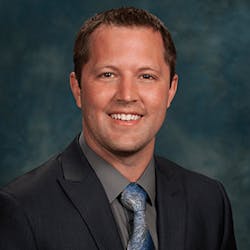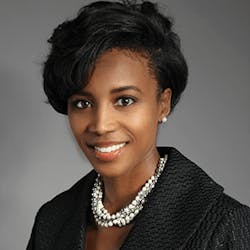Executive Insights: Meet the ISE EXPO 2021 Tech Talk Presenters
Now in its 5th year, the very popular Tech Talks at ISE EXPO 2021 once again offer a variety of network topics from these featured industry experts.
Recently, ISE magazine shared a variety of questions with our Tech Talk presenters. Here are the questions they selected and their answers.
Ross Petrick started in the Telecommunications industry in 1999. He has worked for municipal, and cooperative-owned telecommunications companies around South Dakota, including Swiftel Communications and Golden West Telecommunications. For 12 years, Ross worked, and was a shareholder, at Vantage Point Solutions, a consulting firm based out of Mitchell, SD. Ross has had positions ranging from engineering, product development, and regulatory consulting for clients across the US, and currently sits on the board for SDN Communications. Since starting as the GM/CEO of Alliance Communications Cooperative, Inc. in 2016, Alliance has added over 700 miles of fiber in rural South Dakota, Minnesota, and Iowa, and has been successful in securing many state and nationally funded broadband expansion projects as well. Alliance has provided voice, video, and broadband service, to its cooperative members for over 64 years.
Ross grew up in a small town in South Dakota, graduated with a BS in Economics from South Dakota State University, and lives in Garretson, SD, with his wife, Katie, and 2 children.
TOPIC: PRIORITIES
ISE: Please share 2 successful network updates related to your company’s top objectives for 2021.
Ross Petrick: Alliance is a relatively small regional communications provider that has been 100% Fiber-to-the-Home since 2014. So, most of our recent network upgrades or improvements have been geared toward eliminating bottle necks at our network edges, like transport networks and customer Wi-Fi router options. This has allowed us to offer better Wi-Fi coverage, speed, and service options to the customer.
We also implemented better network access control elements that allow us more visibility into the network and more capability to assist our techs, CSRs and ultimately customers with real-time data and network management. 2021 goals are about keeping people connected and increasing their satisfaction with our service.
With these improvements, we have seen increased Google review scores, experience fewer truck rolls, and have happier customers, especially over the increased demand since the COVID-19 pandemic started.
While it’s less of a network upgrade and more of a network expansion, we have been working with different state and federal programs expanding into areas that don’t have broadband or lack sufficient service. We have expanded our fiber miles by 20% over the last 5 years and plan on doing more in 2022, 2023 as well. While some carriers stop at the city limits, or focus on fixed wireless, we are focusing on putting fiber in the ground to address the needs of today and tomorrow.
TOPIC: SKILLS GAP
According to a recent survey by EY, 59% of companies believe there’s an industry-wide shortage of the type of skills that would help accelerate their digital transformation efforts. (Source: https://www.ey.com/en_us/consulting/six-habits-of-digital-transformation-leaders)
ISE: Share what you are doing for your team members to ensure that you are helping close this gap. And what is the ONE piece of advice you can give to our 27K readers about growing their career?
Petrick: The size of our company allows us to change and adapt quickly while still keeping an eye on the communities and customers that depend on our network.
Networking basics are important. However, much of what is needed today is to educate customers and to be aware of how to maintain safe and secure connections to their devices. Broadband skills need to include the basics on how to educate, train, and support networks, all the way to and including the customer device.
Understanding IP routing and cybersecurity protocols are extremely important but understanding and educating in the gap between data engineering and connecting that consumer device is key. Anyone who understands these technical matters and can communicate with coworkers on a basic level will grow in this industry.
TOPIC: FIBER AND 5G
5G will soon enable transformative new services — like connected cars and precision agriculture. It will also stimulate economic productivity and jobs. But the future of wireless is inextricably linked to the ability to deploy fiber infrastructure across the country. If we want to bring economic productivity and jobs, the industry must deploy more fiber to everyone.
ISE: What are some creative solutions your company is employing to make FTTx-to-Everywhere a reality?
Petrick: Alliance started building fiber-to-the-home for our customers in Iowa, Minnesota, and South Dakota, in 2004, and achieved 100% fiber by 2014. We were offering data speeds over fiber when dialup modems were still a thing, and we now offer 1 Gig symmetrical to whomever thinks they need it.
5G may be the next new thing in wireless, but it depends on a fiber-rich backbone to increase its reach and capacity. Fiber-to-the-Everywhere has been a reality in our network for many years now. We have been able to scale up our network as bandwidth demands continue to increase, without the need for additional spectrum or major network overhauls.
We continue to see the need to update, maintain CPE, access equipment, and transport electronics, to keep up with data demands, but building that core fiber architecture is the key.
TOPIC: $$$ FOR SATELLITE DEPLOYMENTS
The Rural Digital Opportunity Fund (RDOF) is an FCC initiative designed to inject billions of dollars into the construction and operation of rural broadband networks. It recently awarded SpaceX (and its Starlink product) $885 million in its Phase 1 auction. (Phase 1 RDOF allocated $9.2 billion; Phase 2 auction will allocate $11.2 billion.) SpaceX has committed to use the money to bring its satellite service to 642K rural homes and businesses across 35 states with its fleet of about 700 low-Earth orbit (LEO) satellites.
Amazon’s Project Kuiper plans to invest $10 billion to deploy 3,236 LEO satellites and deliver satellite-based broadband across the US. It aims to provide backhaul for wireless carriers and help bring LTE and 5G services to new regions in the US.
ISE: Share your thoughts about how this impacts the competitive landscape, and how it will help bridge the Digital Divide in the near future.
Petrick: The one-size-fits-all approach works for stocking hats and scarves, but it does not work for closing the Digital Divide. What works in South Carolina does not work in South Dakota, and vice versa. I appreciate that we have many different technologies to help tackle the Digital Divide, and also appreciate that Congress, the FCC, and others, realized the importance of broadband and closing the gap.
However, I don’t believe there is just one approach for connecting the unconnected. What we need
to be supporting are proven technologies, not advertised speeds, marketing hype, or promises. It takes more than an idea to build broadband to areas that don’t have it. It takes setting up rules and procedures to support robust and scalable broadband services for years to come.
Opinion is to back technologies that can grow with customer demands and that have proven service and support history. Satellite and wireless have a place in the process, but what we should be focusing on is tackling current demand, while considering future needs. For that purpose, my bet is on fiber and technologies that have a proven track record of providing reliable broadband.
TOPIC: PAIN POINTS
ISE: What are 2 of your company’s biggest network-related challenges right now?
Petrick: Keeping up with customer demands, and making sure we stay on top of the supply chain as we look to expand and put some of these federal and state programs to work, is key at our organization today.
TOPIC: RISK
ISE: What’s the biggest professional risk you’ve taken?
Petrick: Saying "Yes" to this speaking engagement!
Don’t miss the ISE EXPO 2021 Tech Talks in Fort Worth, Texas on September 2. Learn about the plethora of IRL solutions and value adds at www.iseexpo.com. Register today for 50% Discount off a full attendee conference pass!
REGISTER HERE
Claudia Coleman is Vice President of Technical Care and is responsible for providing technical support for more than 20 million wireline and IP-based customers. In addition, her team owns Back Office Support, Consumer Product Experience and Enterprise Messaging.
Prior to this role, she served as Assistant Vice President of National Consumer Dispatch, where she led a team that drove the strategy and oversaw the execution of IP and Satellite dispatch theory.
Claudia has over 20 years of business acumen in developing business strategy, supporting goals, driving KPIs and leading large teams. A true Service Designer at heart, she has proven her ability to combine creative and usability viewpoints to implement strategic initiatives and projects resulting in top customer experiences and strong business results. She is inspired by opportunities to lead and collaborate with teams that have a transformational mindset and are passionate about their impact.
In addition to her AT&T responsibility, and #1 job as WIFE & MOM, Claudia is active in her community, committed to supporting STEAM initiatives for underserved students. Claudia earned her BSBA from the University of Missouri and her MBA from the University of Dallas.
TOPIC: BUILDING BLOCKS
ISE: Prior to this role, you served as Assistant Vice President of National Consumer Dispatch, where you led a team that drove the strategy and oversaw the execution of IP and Satellite dispatch theory. How did your previous role prepare you to excel in your current one?
Claudia Coleman: Before I served in the Dispatch organization, I spent years in the Field and our Network Ops Centers, leading teams and maneuvering those challenges.
My understanding of that customer experience end to end, allows me to work with my team on how we approach the customer differently at the beginning of that engagement. In Technical Care, our number one objective is to resolve expeditiously and to the customer’s satisfaction.
We are more motivated to improve diagnostics so that our team can resolve at the first opportunity or set our dispatch and field partners up for success.
TOPIC: CHANGES IN CUSTOMER EXPERIENCE
ISE: In terms of customer experience, it used to be about the last mile. In the current landscape, many say forget the Last Mile — it’s all about the last few feet (or even inches) of the customer experience. Share your thoughts about this.
Coleman: We actually have a differing perspective at AT&T. While the Last Mile, feet, and inches are certainly important, we believe our customers deserve a top-tier experience from the very beginning of their journey with us — not just the end. That’s why we’ve been making significant investments in our technology and processes, we’re improving our products and services, and making it easier for our employees to better serve customers with updated tools like Salesforce. This commitment is paying off as we were ranked #1 in Customer Satisfaction in the J.D. Power 2020 Residential Internet Service Provider Satisfaction Study in the South, West, and North Central Regions — everywhere we offer Internet.(1)
We plan to continue improving the customer experience across all of our products and services long-term.
(1) AT&T/DirecTV received the highest score in the north central, south and west regions in the J.D. Power 2020 U.S. Residential Internet Service Provider Satisfaction (ISP) Study of customers’ satisfaction with their current Internet service provider. Visit jdpower.com/awards.
TOPIC: THE SHE-CESSION
The COVID-19 pandemic created what some call a she-cession with record numbers of women leaving the workforce. The challenges such as pay disparities and expensive childcare that already challenge women workers more than men have increased since the COVID-19 pandemic. One particularly sobering number: According to the U.S. Bureau of Labor Statistics, there were 2.2 million fewer women in the labor force in October 2020 than there were in October 2019. (Source: https://www.bls.gov/news.release/empsit.t01.htm)
ISE: What is AT&T doing to help reduce the number of women leaving its workforce?
Coleman: Without women, companies can’t reach their highest potential. We are innovators, team players, and leaders, and that value is absolutely recognized at AT&T. While many women unfortunately did have to leave the workforce in 2020, our retention rate for all women at AT&T during this time was 79%. That’s a number on par with pre-pandemic years. Forty-three percent (43%) of our new hires in 2020 were women, and we’re continuing to place an emphasis on promoting women, creating paths for leadership, and providing tools and resources to support their career development and advancement. I am a mother of 2 with a full soccer and baseball mom schedule, and was recently promoted to a more demanding role — AT&T understands the need for balance and they celebrate it.
TOPIC: FIBER TO 90 METRO AREAS
AT&T expects to expand its network to provide broadband Internet service via fiber to 3 million more residential and business locations in more than 90 metro areas.
ISE: The devil is in the details, of course. What are some best practices other providers can borrow from AT&T’s success in deploying fiber across varied municipalities despite differing ROW requirements and community involvement?
Coleman: In 2014, when I served as Field Director for Southwest Texas, we successfully launched our 100% fiber network in Austin, Texas, fulfilling a strong desire for reliable Internet and speed. Since then, that momentum has certainly grown and is continuing to grow at an impressive pace. Not only are we consistently upgrading the electronic equipment located at each end of the fiber optic network and at the customer’s home to provide higher bandwidth and efficiency, but in wire centers where we already have fiber-capable infrastructure in place, we are also leveraging that infrastructure to further accelerate our build. This way, we’re able to deploy in adjacent neighborhoods and other successive areas more quickly.
By putting the community’s need first and foremost, and also investing in good relationships with municipalities in order to streamline the permitting process, your team will have the same desire to be creative and expand as quickly as possible for customers.
Don’t miss the ISE EXPO 2021 Tech Talks in Fort Worth, Texas on September 2. Learn about the plethora of IRL solutions and value adds at www.iseexpo.com. Register today for 50% Discount off a full attendee conference pass!
REGISTER HERE
Trent Clausen is the Vice President of Technical Operations for Comcast’s Twin Cities Region. Trent joined the Comcast team in August 2018. He is responsible for a team of over 400 individuals who complete Comcast customer installations and repairs in the Twin Cities Region, which includes Minnesota, Wisconsin, Kansas, and Missouri.
Trent started his career in the telecommunications industry more than 20 years ago as a Supervisor in Repair Screening with US West. He progressed into roles with increased scope and responsibility, including positions in Installation & Maintenance Field Operations, Dispatch Operations, Engineering, Construction, Capital and Network Planning.
Prior to joining US West, Trent spent 7 years serving in the U.S. Army where he earned the rank of Captain. His primary training was in aviation, with advanced schooling in aviation maintenance, production control, quality assurance, product life-cycle management and combined logistics operations. He served one year in Korea, with the remainder of his service in the United States.
Trent holds a bachelor’s degree in aeronautical studies from the University of North Dakota and an MBA from the Carlson School of Management at the University of Minnesota. He has completed certification courses in Lean/Six Sigma Black Belt, machine learning, and leadership. He is a graduate of the Minnesota Technology Association’s (MTA) ACE Leadership Program and a current MTA Board member.
Trent and his wife, Carrie, reside in Elk River where he enjoys fishing, hunting, CrossFit, and mountain biking. He actively supports the arts and youth sports in his community. Trent currently serves on the board of the United Heroes League, which works to ensure children of military families have every opportunity to participate in youth sports.
ISE: Please share 2 successful network updates related to your company’s top objectives for 2021.
Trent Clausen: Throughout 2020, Comcast continued to deliver above-advertised speeds to customers across the country, including in areas most affected by COVID-19. The remarkable performance of the network during this time can be attributed to outstanding work by engineering and care teams, key innovations, and billions of dollars in strategic investment for many years before the pandemic began. Comcast engineers built multiple new smart software platforms — powered by artificial intelligence and machine learning — that can detect and fix problems before they affect customers. One of those software platforms is Comcast Octave, the completion of which was dramatically accelerated by Comcast engineers in response to the COVID-19 pandemic. Comcast Octave increased upstream capacity by up to 36%, right at the time when traffic levels began to surge.
Separately, we also achieved a 10G technical milestone in a trial delivering symmetrical 1.25 gigabit-per-second upload and download speeds over a live production Distributed Access Architecture (DAA) network, using Network Function Virtualization (NFV). This technology will be key to making multi-gigabit symmetrical speeds widely available as part of Comcast’s future, next-generation offerings.
TOPIC: CUSTOMER CARE
ISE: Companies that prioritize innovation and care in redesigning customer experiences will be best positioned to stay ahead of shifting consumer preferences. What 2 innovative customer-centric initiatives can you recommend to other providers that your teams do extremely well?
Clausen: We’ve worked hard to create digital solutions that are smart, interactive, and predictive. Our multi-year investment in digital platforms and capabilities, like artificial intelligence and machine learning, are paying off as more people rely on digital interactions with companies more than ever. In particular, usage of Xfinity Assistant, our always-on digital assistant, increased 445% in the past year with 82% of customers successfully getting the support they needed. Xfinity Assistant answers customers’ questions on hundreds of topics, including billing, service issues, equipment upgrades, and other key areas that our customers frequently ask us about. And it’s integrated across our products so that no matter when a customer needs us, we are there to help. And if Xfinity Assistant can’t help, it will seamlessly transfer you to a live agent who can.
TOPIC: SKILLS GAP
ISE: According to a recent survey by EY, 59% of companies believe there’s an industry-wide shortage of the type of skills that would help accelerate their digital transformation efforts. Share what you are doing for your team members to ensure that you are helping close this gap.
Clausen: We believe that you can’t have a great customer experience without a great employee experience. That’s why we take a holistic approach to supporting employees, including employee benefits, training, product education, and by providing world-class employee tools with built in insights and knowledge that help our employees provide a better, more seamless, experience to customers. For example, we’re using the Xfinity Assistant to empower agents with more insights on what the customer has already requested so that they don’t have to repeat the experience with a live agent. The agent sees they were using Xfinity Assistant and can more readily provide information to assist the customer.
TOPIC: HONESTY
ISE: What is it like to work for you?
Clausen: My direct reports would be the best to answer this question on my behalf. I hope they would say that I’m fair, honest, like to enjoy my working hours through hard work, but not afraid to enjoy a laugh. While still very competitive, I’m more interested in building the machine that delivers results for our customers while keeping our employees top of mind. I enjoy the challenge of learning new things and seeing my team’s eyes light up when a critical insight is made, so they make progress a reality.
ISE: What is the ONE piece of advice you can give to our 27K readers about growing their career?
Clausen: Consider that your career path is not, and should not be, a straight line. Whatever your specialty, craftsman or professional, technical or operations, consider that you are a better provider by having been a customer, and having seen the system you’re working in from multiple perspectives. When I interview, I look for candidates that have had more than one perspective on a delivery system. For example, having a candidate with experience as a technician, network engineer, and a sales supervisor, is a tremendously powerful set of experiences for a leader or technical candidate. These are very diverse experiences, and generally not found without some intentional moves by the candidate.
Join us at ISE EXPO 2021 in Fort Worth, Texas (August 31 – September 2, 2021) and experience why network professionals from around the globe attend our engaging seminars, commanding keynote speakers, solutions based vendors and face-to-face networking.
REGISTER HERE
About the Author
Sharon Vollman
Content Ambassador for ISE EXPO
Sharon Vollman is the Content Ambassador for ISE EXPO. She is passionate about collaborating with thought leaders, SMEs and hard-working doers who design, plan and deploy ultra-reliable broadband networks. Vollman is committed to creating a variety of educational offerings for ISE EXPO attendees that inspire them to connect every U.S. citizen with the broadband networks we all want for our children and grandchildren.
Vollman has created educational partnerships with Broadband Service Providers including AT&T, Verizon, Lumen, Frontier Communications and others. She has covered the telecom industry since 1996.







